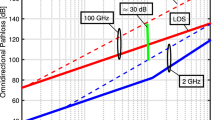Abstract
The development of various radio planning tools for the design of fixed and mobile communication systems requires radio channel measurements, comparison with various models, and the tuning of various parameters involved in the model. Based on the various land- and rail-based VHF/UHF measurements over northern, southern, western, and eastern parts of Indian subcontinent, the parameters of Okumura–Hata model are tuned, and modified parameters for the above regions have been deduced. These can be utilized for the design and development of future broadcast systems, mobile communication systems in this region of the world.








Similar content being viewed by others
References
Prasad MVSN, Singh R (2000) UHF train radio measurements over northern India. IEEE Trans Veh Technol 49(1):239–245
Prasad MVSN, Singh R (2003) Terrestrial mobile communication train measurements over western India. IEEE Trans Veh Technol 52(3):671–682
Prasad MVSN, Singh R, Sarkar SK, Sarma AD (2006) Some experimental and modelling results of widely varying urban environments on train mobile radio communication. Wireless communication and mobile computing, vol 6. Wiley, UK, pp 105–112
Prasad MVSN, Ahmad I (1997) Comparison of some path loss prediction methods with VHF/UHF measurements. IEEE Trans Broadcast 43(4):459–486
Rama Rao T, Rao SVB, Prasad MVSN, Sain M, Ahmad I, Lakshmi DR (2000) Mobile radio propagation path loss studies at VHF/UHF bands in southern India. IEEE Trans Broadcast 46(2):158–164
Medesis A, Kajackas A (2000) On the use of the Universal Okumara–Hata propagation prediction model in rural areas. Proceedings of the 51st Vehicular Technology Conference, IEEE, vol. 3, pp 1815–1818
Hattori T, Shiokawa T, Abe K (2000) Measurement of microwave, millimeter-wave band propagation characteristics in environments along railway tracks. Proc ISAP 1:321–324
Okumura Y, Ohmori E, Kawano T, Fukuda K (1968) Field strength and its variability in VHF and UHF land-mobile service. Rev Electr Commun Lab 16(9–10):825–878
Hata M (1980) Empirical formula for propagation loss in land mobile radio services. IEEE Trans Veh Technol 29:317–325
Blaunstein N, Andersen JB (2002) Multipath phenomena in cellular networks. Artech House, Artech House Mobile Communication Series
Simi IS, Stani I, Zrni B Minimax LS Algorithm for automatic propagation model tuning. http://www.telfor.org.yu/telfor2001/radiov1/4–12.pdf
Author information
Authors and Affiliations
Corresponding author
Appendices
Annexure A
The detailed specifications of receiver RFT SMV-8 are given below.
-
1.
The frequency is subdivided into five ranges: 30–66 MHz, 66–142 MHz, 142–300 MHz, 300–600 MHz, 600–1,000 MHz.
Error of the frequency scale after calibration onto the next frequency marker, ±3 × 10−3 f input + 200 kHz
-
2.
Error with the measurement of voltage ratios.
Error of the voltage divider within the frequency range 30–300 MHz, ±0.6 dB; 300–1,000 MHz, ±0.9 dB.
-
3.
Input impedance = 50 Ω, RF instrument connector series N
-
4.
Selectivity properties
-
4.1.
Bandwidths 120, 20, 1 KHz (for sweep operation, the additional error of the voltage measurement is ±0.5 dB)
-
4.2.
IF selectivity
Table 4 -
4.3.
Image frequency rejection with in the frequency range 30–300 MHz, >80 dB; 300 MHz–1,000 MHz, >60 dB Amplitude and frequency demodulation facility available
-
4.1.
-
5.
Receiver sensitivity
12 dB or better for a level of −107 dBm (1 μV). Signal to noise ratio of 50 dB or better for RF level of −87 dBm of 10 μV at antenna port
-
6.
Environmental conditions
Operational conditions class according to GDR standard, TGL 9200 B1.1, TII.
Extended ambient temperature range −30°C to +50°C. Instrument meets the environmental testing requirement according to USSR standard GOST 9763-67, group of instruments IV.
Transmitter was operating on amplitude modulation radiating output power of 5 W with a omnidirectional monopole antenna. Receiving antenna is a yagi with gain of 12 dBi.
Annexure B
Rights and permissions
About this article
Cite this article
Prasad, M.V.S.N., Ratnamala, K., Chaitanya, M. et al. Terrestrial communication experiments over various regions of Indian subcontinent and tuning of Hata’s model. Ann. Telecommun. 63, 223–235 (2008). https://doi.org/10.1007/s12243-008-0022-9
Received:
Revised:
Accepted:
Published:
Issue Date:
DOI: https://doi.org/10.1007/s12243-008-0022-9




